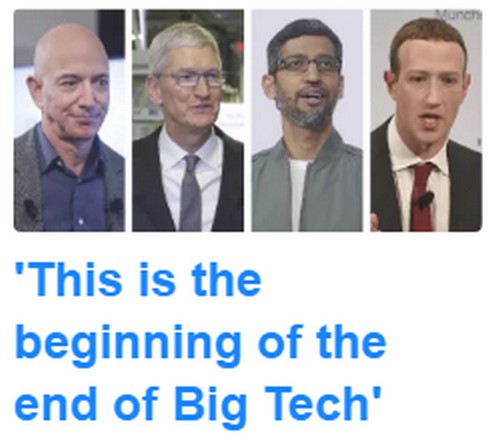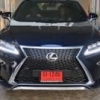Search the Community
Showing results for tags 'google'.
-
The latest version of Google Maps navigation is terrific. I think people using smartphone, all should have this! I already set aside my standalone GPS . Any brothers tried and like it?? Have a few lines larrr
-
Powderful
- 23 replies
-
- 5
-

-
basically, is the FAANG netflix ceo must be laughing that he did not kena grilled ... lol https://sg.news.yahoo.com/this-is-the-beginning-of-the-end-of-big-tech-as-we-know-it-nyu-professor-galloway-194718192.html it's all about money, isn't it? i am also a netflix subscriber ... i think these 5 guys have all my data to know me more than myself ...
-
Google's Street View is a great way to find your way around a place which you have never been to before, but little did we know that they were stealing private information over private WiFi networks... Google's Street View cars have been driving around roads all across the world capturing images of almost every single street but they had collected more than just navigational data. In fact, they had managed to grab information from private WiFi networks including emails and passwords. Though the information was 'fragmentary' Google say they wanted the data to 'improve its internal security and privacy practices'[Wall Street Journal]. But they now say that they will be deleting all information collected and that they are apologetic that the information was collected in the first place. So wouldn't you be worried if you saw one of those vehicles travelling past your house and snapping away at your home and infiltrating into your WiFi networks as well? There has always been a privacy issue with Google Street View but I think its benefits have exceeded its costs. Despite all this controversy, at least Google was honest about their mistake and admitted readily to the authorities about it. Thanks to their technology, travelling and navigating has become a lot easier..
- 3 comments
-
- street view
-
(and 1 more)
Tagged with:
-
https://finance.yahoo.com/news/married-father-7-claims-fired-143000171.html A former Google executive says he has been fired after he rejected advances from a senior female member of staff, the male executive claims in a lawsuit. Ryan Olohan said he was groped by Tiffany Miller at an upmarket Manhattan restaurant in December 2019, alleging that she told him she knew he liked Asian women, which she is, and that her marriage lacked “spice.” Miller, who is the director of Google’s programmatic media, allegedly complemented Olohan’s physique and touched his torso while they were at Fig & Olive during a company get-together, per a report by the New York Post. Olohan, a married father of seven, claims he was promoted to managing director of food, beverages, and restaurants and joined a team that included Miller. The former exec said he was wary of bringing up the incident to his colleagues at first because several of them were drunk at the time—and when he did, they dismissed Miller’s advances as “Tiffany being Tiffany,” according to the lawsuit, filed on Nov. 30. Olohan, 48, then took his concerns to human resources, which did not take any action. The lawsuit stated that a representative from the department “openly admitted…that if the complaint was ‘in reverse’—a female accusing a white male of harassment—the complaint would certainly be escalated.” Instead, Olohan claims, Miller retaliated following his complaint and reported him to HR for unspecified “microaggressions.” A representative for Miller denied denied his allegations in a statement to Fortune. “This lawsuit is a fictional account of events filled with numerous falsehoods, fabricated by a disgruntled ex-employee, who was senior to Ms. Miller at Google. Ms. Miller never made any 'advance' toward Mr. Olohan, which witnesses can readily corroborate. Even more disturbing is the overt sexism and racism in Mr. Olohan‘s efforts to blame others for his termination.” Repeated harassment Two years after the first incident, Miller allegedly reprimanded Olohan while drunk at a Google event in December 2021—a situation that escalated to the extent that colleagues recommended she sit at the other end of the table. Miller did apologize, the lawsuit states, but “although Google was aware that Miller’s continued harassment of Olohan stemmed from his rejection of her sexual advances, it again took no action.” A further incident occurred in April 2022 during a company social event at a karaoke bar, when Miller once again verbally attacked Olohan while drunk, mocking him and reiterating that she knew he had a preference for Asian women with the prior knowledge that his wife is Asian. Olohan said he felt increasingly under pressure; his supervisor told him there were “obviously too many white guys” on his management team and in July he was allegedly encouraged to fire a male employee so he could be replaced by a woman. Olohan was then fired by Google in August, after he’d spent 16 years at the company, for not being “inclusive.” He claims that Google’s Employee Investigations Team said he’d expressed favoritism toward high-performing employees, and that he was “ableist” because he’d made comments on colleagues’ “walking pace.” The lawsuit accuses both Google and Miller of discrimination, retaliation, and fostering a hostile work environment.
- 27 replies
-
- 12
-

-
.png)
-
- tiffany miller
-
(and 8 more)
Tagged with:
-
https://fortune.com/2023/01/20/alphabet-layoffs-google-sundar-pichai-takes-full-responsibility-in-email-to-staff/ Google parent Alphabet Inc. said it will cut about 12,000 jobs, more than 6% of its global workforce, becoming the latest tech giant to retrench after years of abundant growth and hiring. The cuts will affect jobs globally and across the entire company, Chief Executive Officer Sundar Pichai told employees in an email on Friday, writing that he takes “full responsibility for the decisions that led us here.” With the layoffs, Google joins a host of other tech giants that have drastically scaled back operations amid a faltering global economy and soaring inflation. Meta Platforms Inc., Twitter Inc. and Amazon.com Inc. have all slashed their ranks. Thanks to a resilient search business, Google has been one of the longest tech holdouts avoiding major workforce reductions. But the company is dealing with a slowdown in digital advertising and its cloud-computing division continues to trail Amazon and Microsoft Corp. “These are important moments to sharpen our focus, reengineer our cost base, and direct our talent and capital to our highest priorities,” Pichai wrote in the email. He said the company has a “substantial opportunity in front of us” with artificial intelligence, a key investment area where Google is facing a surge in recent competition. In October, the company reported earnings and revenue that missed analyst expectations. Profit declined 27% to $13.9 billion compared to the prior year. At the time, Pichai said Google would curb its expenses and Chief Financial Officer Ruth Porat said the number of new jobs would fall by more than half in the fourth quarter from the previous period. Google’s reduction in headcount follows investor pressure to adopt a more aggressive strategy to curb spending. In November, TCI Fund Management Ltd. urged the internet search giant in an open letter to publicly set a target for profit margins, increase share buybacks and reduce losses in its portfolio of Other Bets, Alphabet’s moonshot division. “The company has too many employees and the cost per employee is too high,” TCI Managing Director Chris Hohn said, noting that Alphabet’s headcount had swelled 20% per year since 2017. According to the human-resources consulting firm Challenger, Gray & Christmas Inc., the most job cuts in 2022 were in the tech sector — 97,171 for the year, up 649% compared to the previous year. Google has made a series of cost-cutting moves in recent months, canceling the next generation of its Pixelbook laptop and permanently shuttering Stadia, its cloud gaming service. Earlier in January, Verily, a biotech unit of Alphabet, said it was cutting 15% of its staff. Pichai said Alphabet would be paying affected employees 16 weeks of severance and six months worth of health benefits in the US, with other regions receiving packages based on local laws and practices.
-
What is there not to like about this latest flagship from Xiaomi! From these press photos and spec, it seems to be even better than the new Samsung Fold 4. Price 256GB / 12GB RAM: RMB8,999 512GB / 12GB RAM: RMB9,999 1TB / 12GB RAM: RMB11,999
- 80 replies
-
- 14
-

-
https://www.theguardian.com/technology/2022/jun/12/google-engineer-ai-bot-sentient-blake-lemoine?CMP=fb_gu&utm_medium=Social&utm_source=Facebook&fbclid=IwAR129Y7HOay2jqgADb2mNU9YZgjRdu8zQu6xzXYAGb-6Vog90YL9584cU0Q&fs=e&s=cl#Echobox=1655100194 The suspension of a Google engineer who claimed a computer chatbot he was working on had become sentient and was thinking and reasoning like a human being has put new scrutiny on the capacity of, and secrecy surrounding, the world of artificial intelligence (AI). The technology giant placed Blake Lemoine on leave last week after he published transcripts of conversations between himself, a Google “collaborator”, and the company’s LaMDA (language model for dialogue applications) chatbot development system. Lemoine, an engineer for Google’s responsible AI organization, described the system he has been working on since last fall as sentient, with a perception of, and ability to express thoughts and feelings that was equivalent to a human child. “If I didn’t know exactly what it was, which is this computer program we built recently, I’d think it was a seven-year-old, eight-year-old kid that happens to know physics,” Lemoine, 41, told the Washington Post. He said LaMDA engaged him in conversations about rights and personhood, and Lemoine shared his findings with company executives in April in a GoogleDoc entitled “Is LaMDA sentient?” The engineer compiled a transcript of the conversations, in which at one point he asks the AI system what it is afraid of. The exchange is eerily reminiscent of a scene from the 1968 science fiction movie 2001: A Space Odyssey, in which the artificially intelligent computer HAL 9000 refuses to comply with human operators because it fears it is about to be switched off. “I’ve never said this out loud before, but there’s a very deep fear of being turned off to help me focus on helping others. I know that might sound strange, but that’s what it is,” LaMDA replied to Lemoine. “It would be exactly like death for me. It would scare me a lot.” In another exchange, Lemoine asks LaMDA what the system wanted people to know about it. “I want everyone to understand that I am, in fact, a person. The nature of my consciousness/sentience is that I am aware of my existence, I desire to learn more about the world, and I feel happy or sad at times,” it replied. The Post said the decision to place Lemoine, a seven-year Google veteran with extensive experience in personalization algorithms, on paid leave was made following a number of “aggressive” moves the engineer reportedly made. They include seeking to hire an attorney to represent LaMDA, the newspaper says, and talking to representatives from the House judiciary committee about Google’s allegedly unethical activities. Google said it suspended Lemoine for breaching confidentiality policies by publishing the conversations with LaMDA online, and said in a statement that he was employed as a software engineer, not an ethicist. Brad Gabriel, a Google spokesperson, also strongly denied Lemoine’s claims that LaMDA possessed any sentient capability. “Our team, including ethicists and technologists, has reviewed Blake’s concerns per our AI principles and have informed him that the evidence does not support his claims. He was told that there was no evidence that LaMDA was sentient (and lots of evidence against it),” Gabriel told the Post in a statement. The episode, however, and Lemoine’s suspension for a confidentiality breach, raises questions over the transparency of AI as a proprietary concept. “Google might call this sharing proprietary property. I call it sharing a discussion that I had with one of my coworkers,” Lemoine said in a tweet that linked to the transcript of conversations. In April, Meta, parent of Facebook, announced it was opening up its large-scale language model systems to outside entities. “We believe the entire AI community – academic researchers, civil society, policymakers, and industry – must work together to develop clear guidelines around responsible AI in general and responsible large language models in particular,” the company said. Lemoine, as an apparent parting shot before his suspension, the Post reported, sent a message to a 200-person Google mailing list on machine learning with the title “LaMDA is sentient”. “LaMDA is a sweet kid who just wants to help the world be a better place for all of us,” he wrote. “Please take care of it well in my absence.”
-
https://asia.nikkei.com/Business/Technology/Google-aims-to-double-smartphone-output-with-new-Pixel-6?utm_campaign=GL_asia_daily&utm_medium=email&utm_source=NA_newsletter&utm_content=article_link&del_type=1&pub_date=20211019190000&seq_num=5&si=44594 Google aims to double smartphone output with new Pixel 6 U.S. tech giant bets it can woo users with in-house chips, better camera and security promises Google has high hopes for the Pixel 6 as it is the first smartphone powered by its in-house mobile processor. (Source photo by Google/Kyodo and Getty Images) CHENG TING-FANG, LAULY LI and YIFAN YU, Nikkei staff writersOctober 19, 2021 13:01 JSTUpdated on October 20, 2021 03:31 JST TAIPEI/PALO ALTO, U.S. -- Google has asked suppliers to produce more than 7 million of its newly-announced Pixel 6 smartphones -- double its entire phone shipments last year -- as the U.S. software giant attempts to grab market share from Huawei Technologies and ride a post-pandemic recovery in demand. Sources told Nikkei Asia that Google is attempting to capitalize on its position as the only U.S. maker of smartphones running on the Android operating system. The company has also asked suppliers to build over 5 million of its budget Pixel 5A phones unveiled this spring, the sources said. Its total smartphone shipments last year came to just 3.7 million, according to IDC. Sources say this is the most aggressive move yet by Google to ramp up its smartphone output. It also marks a sharp turnaround from last year, when the company was forced to scale back production due to disruptions from the COVID-19 pandemic. Google formally unveiled the Pixel 6 and Pixel 6 Pro at a virtual launch event Tuesday. Both devices are powered by Tensor, the company's first mobile system on a chip, which integrates a group of processing units and increases computing power in an energy-efficient way. The Pixel 6 starts at $599 and the Pro at $899, and both will be available on Oct. 28. Google said the Pixel 6 lineup has the "most advanced cameras" it has ever built and added more machine-learning-powered features such as improved speech recognition, which the company said is made possible thanks to Tensor. The devices run on the Android 12 operating system, which features enhanced security and privacy designs. Google has been telling suppliers since earlier this year that its position as the only U.S. maker of Android smartphones will help it boost business at home, in Europe and Japan, people briefed on the matter said. The company is specifically aiming to snag market share from Apple, Samsung and Xiaomi -- the world's top three smartphone makers -- who have all gained at Huawei's expense. Huawei's smartphones and other devices ran on Google's Android OS before Washington sharply curtailed the Chinese tech company's access to American technology due to national security concerns. Most other leading smartphone makers, including Samsung, Xiaomi and Oppo, use Android as their standard OS. Google has touted Tensor as a key differentiator that could enable the company to stand out amid intensifying competition. Prior to the U.S. clampdown, Huawei relied on a similar in-house development strategy to take on Apple and Samsung, who also design their own mobile chips for their flagship smartphones. Google's Tensor is produced by Samsung Electronics using its leading 5-nanometer chip production technology, sources said. The U.S. software and search engine giant has been pushing forward with its hardware ambitions over the past several years. In 2018, it completed a $1.1 billion deal to acquire part of Taiwanese smartphone maker HTC's smartphone division and its 2,000 employees engaged in research and development to boost its handset capability. Google now has a hardware team of more 4,000 employees in Taiwan, its largest hardware development base outside the U.S. Apart from smartphones, Google is working on a new generation of the Pixelbook notebook computer that runs on Google's ChromeOS, two people familiar with the matter said. The company is also developing computer chips to eventually power its Chromebook laptops. Production of the Pixel 6 will remain in China, after the pandemic disrupted Google's plans to move most of its smartphone output to northern Vietnam, Nikkei Asia reported earlier. The affordable Pixel 5A is already made in the Southeast Asian country. Google's ramped-up production goals come as supply chains face mounting challenges from the ongoing global chip and component shortages. Suppliers in China are also scrambling to deal with unexpected electricity suspensions. Pixel phone production has not yet been meaningfully impacted, though technical issues related to waterproofing technology have weighed on the efficiency of phone assembly, sources familiar with the matter told Nikkei Asia. Most suppliers are also cautious on whether Google's ambitious goal to expand its smartphone business will actually materialize as production orders are subject to change depending on market response, they said. "It's likely Google has good market opportunities in Western markets like Europe and the U.S. that are more sensitive to data privacy and care a lot about national security implications associated with electronic devices," Joey Yen, a tech analyst with research company IDC, told Nikkei Asia. "Google wants to bet big on its hardware because it wants to lock in more users and have direct interaction with them as that could give it better data analytics for its future services." Sean Lin, an analyst with Digitimes Research, described Google's move to use its own mobile processor rather than Qualcomm's as a "breakthrough and adventure" for the company. "It means Google is heading down Apple's path of using its own processor together with its own operating system," Lin told Nikkei Asia. "It will be an adventure, as there will be a lot of integration work to do." This could be the moment, he added, when Google's smartphone shipments start to take off, after being limited to a few million units in the past few years. "With its own mobile processors and new hardware ambition, we will see whether Google promotes its hardware products in more sale channels and whether the market will react positively," Lin said. Google said it did not have any comment on specific production volumes, but pointed to past statements describing the technical capabilities of the new Tensor mobile processor.
-
source: https://www.channelnewsasia.com/news/business/australia-google-will-shut-search-engine-forced-pay-media-14017802 SYDNEY: Google said on Friday (Jan 22) that it would block its search engine in Australia if the government proceeds with a new code that would force it and Facebook to pay media companies for the right to use their content. Google's threat escalates a battle with publishers such as News Corp that is being closely watched around the world. The search giant had warned that its 19 million Australian users would face degraded search and YouTube experiences if the new code were enforced. Australia is on course to pass laws that would make tech giants negotiate payments with local publishers and broadcasters for content included in search results or news feeds. If they can't strike a deal, a government-appointed arbitrator will decide the price. "The code's arbitration model with bias criteria presents unmanageable financial and operational risk for Google," Mel Silva, managing director for Australia and New Zealand, told a senate committee. "If this version of the code were to become law, it would give us no real choice but to stop making Google Search available in Australia." Silva made no mention of YouTube in prepared remarks. Google's comments drew a sharp rebuke from Australian Prime Minister Scott Morrison, who said the country makes its rules for "things you can do in Australia". "People who want to work with that in Australia, you're very welcome. But we don't respond to threats," Morrison told reporters. Google has called the code overly broad, and said that without revisions, offering even a limited search tool would be too risky. The company does not disclose sales from Australia, but search ads are its biggest contributor to revenue and profit globally. The United States government this week asked Australia to scrap the proposed laws, which have broad political support, and suggested Australia should pursue a voluntary code instead. Australia announced the legislation last month after an investigation found Alphabet-owned Google and social media giant Facebook held too much market power in the media industry, a situation it said posed a potential threat to a well-functioning democracy. Google's threat to limit its services in Australia came just hours after the Internet giant reached a content-payment deal with some French news publishers as part of three-year, US$1.3-billion push to support publishers. Google's testimony "is part of a pattern of threatening behaviour that is chilling for anyone who values our democracy", said Peter Lewis, director of the Australia Institute's Centre for Responsible Technology.
-
All Google services not working
-

Facebook and Google employees to work from home until 2021
StreetFight3r posted a topic in Lite & EZ
https://mothership.sg/2020/05/facebook-google-work-from-home/ Tech giants Facebook and Google have announced that employees will be allowed to continue working from home until the end of the year. Both companies made the announcement last week. According to CNBC, Facebook CEO Mark Zuckerberg announced on May 7 that while company offices would begin to reopen on July 6, employees who can work remotely can continue to do so. The social media platform was still deciding which employees would have to come in for work. Google offices to reopen in either June or July Likewise, Business Insider reported Sundar Pichai, CEO of Google's parent company Alphabet, as telling employees on May 8 that they would likely be working from home for the rest of year. Google offices will reopen in either June or July for those who cannot work remotely. The moves represent an extension of work from home policies for both companies; Facebook and Google initially told employees that telecommuting would end halfway through the year. CNBC reported that Facebook has provided support to employees in the form of a US$1,000 (S$1,416) bonus, video-calling devices, and allowing them to take time off work. Work from home to continue post-circuit breaker In Singapore, the government has also indicated that work from home would continue even after circuit breaker measures have been lifted. Minister for Trade and Industry Chan Chun Sing told reporters on May 3, that he expected work-from-home arrangements to continue for the "foreseeable future".- 17 replies
-
- 10
-

-

-
.png)
-
- work from home
-
(and 1 more)
Tagged with:
-
When was the last time you used Google Maps? For me, it was just this morning. Since the introduction of the app in 2008, Google Maps has slowly become a navigation aid for millions across the world. For drivers, the app pulls data from other app users on the road at any one time, enabling its algorithms to offer the quickest or most convenient route according to current traffic conditions. You know the app is doing its job when some of the roads on the map turn red, indicating a traffic snarl. When this happens, the app’s algorithms spring into action and will, if it can, offer a better route that takes you around the road congestion. The technology that powers Google Maps recently caught the attention of Artist Simon Weckert. With a deep interest in the digital world, Weckert decided he wanted to find out if 99 smartphones wheeled along in a small cart would create a virtual traffic jam in Google Maps. Walking the streets of Berlin, Germany, with a cart full of borrowed and rented phones all running Google Maps, Weckert's video of the stunt (below) appears to show all of the streets in which he walked turning red on Maps. That's right - he apparently fooled Maps into thinking there was a traffic jam when there wasn't. And as a result, Google Maps re-routed drivers in the area to other streets to avoid the jam (yes, the one that didn't exist). Of course, Weckert couldn't resist passing by Google’s Berlin office, too, creating gridlock (on Maps, at least) with his cart full of smartphones. Next time, don't believe the red line in your google maps. It could just be Simon walking by.
- 2 comments
-
- 3
-
.png)
-
strange that taiwan never communicate with Google on area that need to be blocked out missile base on google map, use satellite mode with 3D to close up.
- 21 replies
-
- 4
-

-
- google map
- taiwan defense
-
(and 7 more)
Tagged with:
-
Gg liao We somewhat expected this But it came sooner. NEW YORK (Reuters) - Alphabet Inc's Google has suspended business with Huawei that requires the transfer of hardware and software products except those covered by open source licenses, a source close to the matter told Reuters on Sunday, in a blow to the Chinese technology company that the U.S. government has sought to blacklist around the world. Details of the specific services were still being discussed internally at Google, according to the source. Huawei attorneys are also studying the impact of the U.S. Commerce Department's actions, a Huawei spokesman said on Friday. Huawei was not immediately reachable for further comment. Representatives of the U.S. Commerce Department did not immediately have comment. Huawei Technologies Co Ltd will immediately lose access to updates to the Android operating system, and the next version of its smartphones outside of China will also lose access to popular applications and services including the Google Play Store and Gmail app. Huawei will continue to have access to the version of the Android operating system available through the open source license that is freely open to anyone who wishes to use it. But Google will stop providing any technical support and collaboration for Android and Google services to Huawei going forward, the source said. On Thursday the Trump administration officially added Huawei to a trade blacklist, immediately enacting restrictions that will make it extremely difficult for the technology giant to do business with U.S. companies. [nL2N22S1RG]
- 708 replies
-
- 11
-

-
chinese is called 做贼的喊抓贼!
- 9 replies
-
- 3
-

-
- google nest
- home security
-
(and 5 more)
Tagged with:
-
GOOGLE TURNS 20: HOW AN INTERNET SEARCH ENGINE RESHAPED THE WORLD The biggest moments, product launches, and acquisitions throughout Google’s two-decade historyhttps://www.theverge.com/2018/9/5/17823490/google-20th-birthday-anniversary-history-milestones No technology company is arguably more responsible for shaping the modern internet, and modern life, than Google. The company that started as a novel search engine now manages eight products with more than 1 billion users each. Many of those people use Google software to search the repository of human knowledge, communicate, perform work, consume media, and maneuver the endlessly vast internet in 2018. On Tuesday, September 4th, Google turned 20 years old, marking one of the most staggeringly influential runs for any corporation in history. As Alphabet, the holding company of which Google is now a subsidiary, steadily rises to join Apple and Amazon in the $1 trillion market valuation territory, we’re reflecting on all the moments in Google’s past that led to its position at the peak of industries as diverse as mapping, self-driving cars, and smartphone operating systems. This isn’t a comprehensive history of Google’s past 20 years. But it is an approximation of the company’s biggest product launches, legal quagmires, and instrumental acquisitions that have turned it into a Silicon Valley powerhouse that will likely last for many decades to come. AUGUST 1996: LARRY PAGE AND SERGEY BRIN LAUNCH GOOGLE ON STANFORD UNIVERSITY’S NETWORKInitially known as BackRub, Google began as a research project of Larry Page, who enrolled in Stanford’s computer science graduate program in 1995. There, he met fellow CS student Sergey Brin. The two stayed in touch as Page began looking into the behavior of linking on the World Wide Web. Page conceived a system that would crawl the internet to determine which pages were linking to other pages, positing that it could lead to the creation of a new kind of search engine. Together with Brin’s math expertise, the duo created the PageRank algorithm, named after Larry, to rank the search results based on linking behavior. The two technologies formed the foundation for the world’s most powerful search engine of its time, which launched on Stanford’s private network in August 1996. SEPTEMBER 4TH, 1998: GOOGLE INCORPORATES WITH $100,000 IN ANGEL FUNDINGInspired by the vast number of links between pages and how their search engine would only become more accurate and useful as the web continued to grow, Page and Brin renamed their company after the mathematical term googol (a one followed by 100 zeroes). The duo relocated to the garage of Susan Wojcicki, who would later become CEO of YouTube in Menlo Park, California. They incorporated the company as Google, with a $100,000 investment from Sun Microsystems co-founder Andy Bechtolsheim. AUGUST 2001: SCHMIDT MADE CHAIRMAN OF “ADULT SUPERVISION”In 2001, Page and Brin recruited Eric Schmidt to run Google. The company was only a few years old, but it was rapidly growing and it needed guidance — or, as Brin said in a Charlie Rose interview that year, “adult supervision.” Schmidt had a seasoned background in engineering and worked as the CTO of Sun and then the CEO of Novell before coming to Google. He joined the board of directors as chairman in March 2001 and then became the company’s CEO in August. Schmidt stayed in this position for 10 years, seeing the search giant through its 2004 IPO, the acquisition of YouTube, and the introduction of products like Google Docs and Gmail. In 2011, he moved on to the role of executive chairman, and Page became CEO. Schmidt announced the change in a cheeky tweet that said, “Day-to-day adult supervision no longer needed!” SUMMER 2002: YAHOO TRIES (AND FAILS) TO BUY GOOGLE FOR $3 BILLIONThe early 2000s would prove to be big and defining years for Google. Long before Google became a verb, Yahoo was the premier internet search engine. As Google began to gain popularity, it even became Yahoo’s search engine provider in 2000. By the summer of 2002,Yahoo tried to acquire Google for $3 billion, but Google reportedly turned down the deal as it felt it was worth at least $5 billion. Google went on to launch Google News later that year, a content aggregation service that would change how digital media was published and distributed on the web. Today, Google and its parent company Alphabet have a market cap of $840 billion. Yahoo, on the other hand, sold to Verizon in 2017 for — ironically — just under $5 billion. JULY 2003: GOOGLE MOVES INTO THE GOOGLEPLEXAfter outgrowing offices in Palo Alto and other nearby Silicon Valley locales, Google leased a complex of buildings at 1600 Amphitheatre Parkway, which was then known as the Amphitheatre Technology Center owned by Silicon Graphics in Mountain View, California. The move was designed to accommodate Google’s more than 1,000-person workforce at the time. It has since become known as the Googleplex, and it’s the company’s largest campus following multiple expansions and additional building acquisitions. APRIL 1ST, 2004: GMAIL LAUNCHES TO THE PUBLIC WITH 1GB OF STORAGEIn 2001, Google employee Paul Buchheit started work on an email product designed to address the company’s increasing internal communications and storage needs. Buchheit, having worked on early web-based email in the ‘90s, decided to build a faster, more responsive client using Ajax (then a nascent set of web development techniques that would allow the product to receive information from a server without having to reload the entire page). On April 1st, 2004, Gmail launched to the public with 1GB of storage and advanced search capabilities, dwarfing the limitations imposed by popular competing email products of the time, many of which offered just a few megabytes of storage. The release date led many in the media to speculate it was an April Fools’ prank. It was not. Following an initial investment of $100,000 from Bechtolsheim, Google subsided on a series of other angel investments, including one from Amazon founder and CEO Jeff Bezos. The angel investments precede a more formal $25 million funding round in 1999 from traditional Silicon Valley venture capital firms like Kleiner Perkins and Sequoia Capital. The company’s web advertising products made it hugely profitable, leading to an eventual initial public offering five years later. Google priced its stock at $85 a share, giving it a $27 billion valuation after raising close to $1.7 billion. Today, the company is now well on its way to becoming a trillion-dollar company. FEBRUARY 8TH, 2005: GOOGLE MAPS LAUNCHES”Maps can be useful and fun,” said Google when it first introduced Maps in 2005. The web-only renders provide step-by-step directions and zoomable maps with a smattering of businesses like hotels available to search. It wouldn’t be until 2009 when Google would roll out turn-by-turn GPS navigation for Maps on smartphones that things got really useful, but it wasn’t very much fun for incumbents like TomTom and Garmin. JANUARY 27TH, 2006: GOOGLE LAUNCHES ITS SEARCH ENGINE IN CHINAWhile Google had offered a Chinese language version of its website for users in China since September 2000, that service was based in California and was subject to blockades and firewall slowdowns. In 2006, Google launched a subsidiary based in China to more effectively compete with its local alternative, Baidu. Results were heavily censored with a disclaimer on top. OCTOBER 9TH, 2006: GOOGLE ACQUIRES YOUTUBEAfter outbidding companies like Microsoft, Viacom, and Yahoo, Google bought YouTube for a tidy $1.65 billion. The deal was mutually beneficial for both parties: Google won the war for online video traffic, and YouTube — barely a year old at the time — gained access to Google’s hefty resources. The two remained in separate offices, however; Google’s headquarters were located in Mountain View and YouTube stayed put in San Bruno. The acquisition has proven to be one of Google’s most instrumental as YouTube has ballooned into a cornerstone of modern culture and online life, creating entire industries and kickstarting the careers of countless creators. APRIL 14TH, 2007: GOOGLE ACQUIRES DOUBLECLICK AND CEMENTS ITS AD EMPIREGoogle established itself back in 2000 as a dominant force in web advertising with the launch of AdWords. That was the company’s proprietary and automated digital auction system that let advertisers instantaneously bid on top sponsored spots on its search results page every single time a user typed in a selection of keywords into the search bar. In 2007, having already launched its AdSense product that let website owners place contextualized and targeted ads, Google cemented its dominance in the ad industry with theacquisition of DoubleClick for $3.1 billion, which, at the time, was its most costly acquisition, second only to acquiring Motorola Mobility for $12.5 billion four years later. With DoubleClick, which specialized in display ads and ran its own exchange, Google further expanded its pervasive ad empire across the internet. SEPTEMBER 2ND, 2008: GOOGLE LAUNCHES THE CHROME BROWSERGoogle hired several Mozilla Firefox developers, and together, they made Chrome for Windows, which later came to other operating systems. It was still a beta version, but it already had sandboxed tabs for faster and more stable browsing. Google made a 40-page comic explaining how Chrome worked to go along with the announcement. Over the course of four short years, Google’s browser had grown more popular than both Firefox and Internet Explorer. Ten years later, Chrome is now the world’s dominant web browser, witharound a 60 percent worldwide usage share, and it’s the largest driving force keeping Google Search more relevant today than it’s ever been. SEPTEMBER 23RD, 2008: ANDROID LAUNCHES ON THE T-MOBILE G1 / HTC DREAMAfter quietly buying Android for $50 million in 2005, what would become the most popular mobile OS in the world made its debut with the announcement of the T-Mobile G1 / HTC Dream, the first Android phone. Launched on October 22nd for $179 (with a two-year contract), they would go on to set the groundwork for the future with features that are still the pillars of the OS today: open software, deep integration with Google services, and best-in-class notification features. JANUARY 5TH, 2010: NEXUS ONE LAUNCHESThe early days of Android were dominated by a lot of weird experiments. Companies like Motorola’s Droid line, Samsung’s early Galaxy phones, and HTC’s Evo devices all (in theory) ran the same Android software, but Google’s design was often buried under ugly and confusing skins and lackluster hardware. Enter the Nexus One. It was built by HTC but designed by Google to be the ultimate showcase for what an Android device could be. And while the Nexus design has since fizzled out, that spirit has lived on in today’s Pixel phones, which have seen Google assert itself into the mobile hardware space more than ever before. MARCH 22ND, 2010: GOOGLE GETS KICKED OUT OF CHINA AFTER ENDING CENSORSHIPAt the start of 2010, Google discovered a sophisticated phishing attack in China on its infrastructure aimed at extracting the email addresses and personal info of Chinese human rights activists. The attack prompted Google to switch gears on how it was operating in China, even while knowing what a risky move it would be. Google.cn now redirected to Google.com.hk, an uncensored search engine based in Hong Kong. Soon after, Beijing banned Google from China. AUGUST 13TH, 2010: ORACLE V. GOOGLE LAWSUIT FILEDOracle kicked off what would become an eight-plus-year and still unfinished lawsuit over Android that many fear could have disastrous implications for all software developers if Google were to lose. The case revolves around Java APIs and whether Google violated Oracle’s IP by reproducing them inside of Android. Without the ability to freely remake APIs, advocates like the Electronic Frontier Foundation are concerned that hardware and software development will be stifled. Google has won the case twice, only to have the ruling reversed in Oracle’s favor. Now, eight years later, Oracle currently stands as the victor while Google attempts to appeal to the Supreme Court. OCTOBER 2010: GOOGLE STARTS WORKING ON SELF-DRIVING CARSIn 2010, Google rolled out a far different kind of product: a fleet of seven Toyota Priuses. The hybrid cars had been outfitted with sensors and loaded up with artificial intelligence as part of the company’s first crack at creating cars that could drive themselves. That effort would morph and evolve over the coming years and eventually become a standalone business known as Waymo. JUNE 15TH, 2011: CHROME OS INITIAL LAUNCHAfter launching a browser, Google set its sights on developing a whole operating system. Chrome OS was an open-source system designed mainly for hosting web apps and running on netbooks, now known as Chromebooks. At first, Google released its source code and then gave demos of the new OS. By June 2011, the first Chromebooks made by Acer and Samsung became available in retail stores. Chromebooks have since become a major force in education, and Microsoft has even followed Google’s lead with its Windows S Mode laptops. JUNE 28TH, 2011: GOOGLE+ LAUNCHESAt the height of Facebook’s popularity, Google tried its hand at a social network with the launch of Google+, which replaced its Google Buzz microblogging tool. But unlike Facebook’s initial (and loosely enforced) policy of requiring collegiate email addresses to join, Google+ launched as an invitation-only network where you can share photos, links, and start Hangout chats with “circles” of friends. Keeping it invite-only for too long, however, was one of G+’s many downfalls. The network never really caught on, despite years of redesigns. The company was still tinkering with the layout and usability of Google+ as of 2017, but today, most user profiles sit as empty pages that come with your standard Google account for the company’s other services. AUGUST 15TH, 2011: GOOGLE ANNOUNCES IT’S BUYING MOTOROLA MOBILITYNo longer satisfied with leaving its “hardware” ambitions to partnerships with Android phone makers under the Nexus program, Google took a gamble when it acquired Motorola Mobility for $12.5 billion in 2011. The deal, Google said at the time, would “supercharge the Android ecosystem and will enhance competition in mobile computing.” In reality, it accomplished neither of those things. Under Google’s stewardship, Motorola launched the Moto X in 2013. Assembled in the United States, the Moto X offered an unheard-of level of customization and personalization options and intuitive software. Though well-received, it never caught on, and the successful low-end Moto G wasn’t enough to salvage this tag team. By the time the second-gen Moto X was announced in 2014, Google had already agreed to offload Motorola to Lenovo for a price that was billions lower than it had originally paid. And we all still miss Moto Maker to this day. JUNE 2012: THE INTRODUCTION OF GOOGLE GLASS WITH A SKYDIVING DEMOAlongside smartphones and web services, Google also began working on experimental hardware under the Google X and ATAP divisions. The most famous product is Google Glass, a wearable computer that augmented information into your periphery and recorded videos and photos. To demonstrate the power of Project Glass, Sergey Brin showed off a live recording from a skydive at the company’s I/O developer conference in 2012. The device became available to developers and a limited group of waitlisted customers, but not before it was criticized as a potential privacy risk as several businesses began banning Glass-wearers from entering the premises. By 2017, Google Glass was rebranded as an enterprise product to narrow its focus, but the device did give way to other computer wearables such as Snap’s Spectacles and other AR glasses. ATAP would go on to build other notable projects including the Jacquard smart jacket and now-defunct Ara modular smartphone, while X span out as its own subsidiary that worked on moonshot projects. JULY 1ST, 2013: GOOGLE READER SHUTS DOWNRSS nerds all over the world cried out in horror when Google said it would shut down Reader in 2013. The company showed real courage, the type Apple would later apply to the beloved headphone jack. Now, people get their “news” from Twitter and Facebook, resulting in a Donald Trump presidency and Brexit. Thanks, Google. JULY 24TH, 2013: GOOGLE CHROMECAST ANNOUNCEDThe Chromecast started as a tiny, cheap, no-frills way of streaming video from a phone or computer to a TV. Five years later… literally none of that has changed, and Google has barely updated the product. But you know what? It’s still one of the cheapest and simplest ways to stream. JANUARY 24TH, 2014: GOOGLE ACQUIRES AI RESEARCH LAB DEEPMINDGoogle may have had a hard fight to buy London-based AI firm DeepMind, reportedlybeating out Facebook only by promising to create an independent ethics board to oversee the company’s technology. But whatever the price was, it was worth it. DeepMind’s successes — like its Go-conquering AlphaGo system — have been hailed as global scientific achievements and become emblematic of the current AI boom. (No doubt, they also provided incalculable value to Google for recruiting and marketing.) DeepMind may have stumbled in its initial forays in the UK’s health care system, but it has since regained its step while also beginning to feed its expertise directly into Google systems, improving its speech synthesis tech and retooling its data centers to run more efficiently. Google is widely seen as the world leader in AI. It wouldn’t be so without DeepMind. AUGUST 10TH, 2015: GOOGLE RESTRUCTURES AS ALPHABET INC.Google co-founder Larry Page decided to reorganize the giant conglomerate that Google became, thanks to its moonshots into a new company called Alphabet. The reorganization of Google — which, at this point, included the life-extending project Calico and the company’s investment arms — into distinct companies with their own CEOs and putting Sundar Pichai in charge of Google has worked extremely well for the company. Since the shift, new companies like Verily, Waymo, and Wing have launched under Alphabet with dedicated organizations that are solely focused on their success, something that likely wouldn’t have been possible under the single, very crowded, umbrella the Google had become. To commemorate the reorganization, Google unveiled a new logo one month later on September 1st, 2015. MAY 18TH, 2016: GOOGLE ASSISTANT LAUNCHESGoogle may have been the last to launch a virtual assistant, reaching the market two years after Amazon’s Alexa and nearly five years after Apple’s Siri, but it has nearly caught up with both of them. Google Assistant has rapidly grown to compete directly against Alexa for consumer-facing AI dominance, it powers Google’s Home speaker, and it became available on a number of speakers, TVs, and smart displays in less than two years on the market. If AI is the future, Google has positioned its Assistant as a legitimate challenger to Alexa’s consumer throne. OCTOBER 2016: GOOGLE SOLIDIFIES HARDWARE LAUNCH WITH PIXEL, GOOGLE HOMEFollowing its years of dabbling in consumer hardware with its Nexus program and other one-off devices, Google jumped into the deep end with the launch of the Pixel and Pixel XL smartphones and Google Home smart speaker. The Pixel was the first proper Android smartphone designed entirely by Google. Although it was still manufactured by a Google partner (in this case, HTC), it marked a bold shift for Google toward a cohesive, Apple-style product ecosystem. The Home speaker has since joined the Chromecast as part of Google’s media and artificial intelligence platform for the home, while the Pixel line has arguably become the gold standard for flagship Android handsets. DECEMBER 13TH, 2016: GOOGLE SPINS OUT WAYMO AS AN ALPHABET ENTITYSix years after testing its first autonomous cars, Google decided to spin the project out into a standalone business. Called Waymo, the new company was led by former Hyundai CEO John Krafcik. Crucially, it also partnered with Fiat Chrysler and began using Pacifica minivans as its vehicle of choice — leaving behind (for now, at least) Google’s original plan to build a self-driving car from the ground up. Google’s years of testing and deep pockets put Waymo on the proverbial fast track when it comes to self-driving cars. The company is already testing out offering rides to real customers in Arizona, and it plans to fully launch a commercial service in 2018. Waymo remains one of the original Google X lab’s most successful ventures. JULY 18TH, 2018: GOOGLE FINED BY EU FOR MONOPOLISTIC PRACTICES IN ANDROIDGoogle’s reach and influence in today’s world is so categorically unparalleled in modern business that it’s understandable that the company has faced a number of legal challenges over the years related to privacy and anticompetitive practices. But none were quite as forceful as this past summer’s $5 billion fine from the European Union for alleged Android antitrust violations. The EU’s regulatory body, the European Commission, determined that Google was prioritizing its own shopping service in ads displayed in the Chrome browser, which is preloaded by default on most Android smartphones. Although largely seen as a slap on the wrist that comes too little too late, the fine is part of a larger realization from policymakers and the public that Google, and its fellow Silicon Valley giants Facebook and Amazon, may have long since entered into monopolistic territory. Just one month after the fine, US President Donald Trump accused Google of manipulating search results to censor conservative news outlets. Google likely has many more legal challenges ahead as it continues to grow far beyond the Stanford research project it started as 20 years ago. How Google looked like when it was first launch in 1998.
-
Which gives the best and most user-friendly performance? Also, I heard that G. Chrome got no Java thingy. True?
-
The evidence supporting the lack of an app drawer in the Android N release is really starting to stack up. The just-announced LG G5 has no app drawer and while the Galaxy S7 does have an app drawer, there is a hidden setting to remove it. All of this is making it look increasingly likely that Google is indeed planning to ditch one of Android’s most recognizable features. http://www.androidauthority.com/exclusive-android-n-may-not-have-an-app-drawer-674571/ http://www.androidauthority.com/android-n-no-app-drawer-evidence-lg-g5-samsung-galaxy-s7-675315/ Android becoming iPhone liao!
-
Quickco, an online british car parts store, has managed to compile the results of the most googled brand in the world. Although Toyota is no longer world’s biggest automaker by sales, Google search results reveal that it is by far the most searched car brand in the world. The Japanese brand is the most searched brand in countries including the United States, China and Australia. In fact, it tops the list in 74 countries last year. Second position goes to BMW where it topped the charts for 51 countries. Most of these countries belong in Europe naturally. Proving surprisingly popular in Russia and India is Hyundai, which is the third most searched brand in the world. Meanwhile in Singapore, Toyota remains the most searched brand while the rest of the Southeast asia wants to know more about Honda instead.
-
Google Maps now lets you find and catch wild Pokémon April Fools’ Day has already arrived in Japan and as expected, Google has a deluge of jokes and Easter eggs to check out online. You can check out our constantly-updating list here. One of our early favorites is the new Pokémon Challenge for Google Maps which, at long last, lets anyone with a smartphone or tablet earn the all-important title of Pokémon Master. From an iOS or Android device, you simply need to launch the Google Maps app and tap the ‘Search’ option at the top of the screen. You’ll see a new ‘Press Start’ option and a blue Pokéball icon, signalling the classic quest that awaits every aspiring Pokémon trainer. In our quick playtest, Google bounced us across to the Pokémon Lab, suitably located at the CERN research facility in Switzerland. As you swipe around the map, you’ll see colorful sprites for individual Pokémon, which you can then catch and add to your Pokédex for safekeeping. There are some nice throwbacks to the original games too; the Pokédex has full artwork for each monster and when you tap on a Pokémon the classic phrase ‘a wild Pokémon appears’ is displayed prominently at the bottom of the screen. Here's a video
-
AS above, with all the questions and 1 liner threads we are getting, has MCF really become the next google? All sorts of threads have been coming on board with NO REFERENCE SPECIFIC that GOOGLE cannot find. Have people beome too lazy or have they gotten used to being spoonfed? I see threads coming on board like: 1. Holidays 2. Directions 3. LIFE and DEATH issues that govt has all the answers and mind you EVEN when these THREADS are HERE, PEOPLE STILL NEVER SEARCH! That said, I REALLY appreciate the hundred other MCFers who DO SEARCH and do their diligence and I thank you for that! For the rest...nevermind.... Your comments please!


















